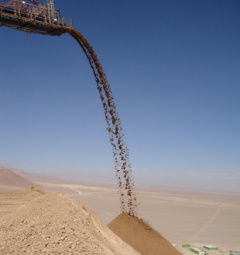Difference between revisions of "Minerals"
| Line 2: | Line 2: | ||
| image = Minerals-2.jpg | | image = Minerals-2.jpg | ||
| origin = - | | origin = - | ||
| − | | stowage factor = Some examples:<br><li>Corrundum (1.10/1.49 m<sup>3</sup>/t; in bags) | + | | stowage factor = Some examples:<br><li>Corrundum (1.10/1.49 m<sup>3</sup>/t; in bags)<li>Graphite (0,93 m<sup>3</sup>/t; in bags)</li> |
| humidity and moisture = | | humidity and moisture = | ||
| ventilation = | | ventilation = | ||
Revision as of 11:58, 14 August 2013
| Infobox on Minerals | |
|---|---|
| Example of Minerals |  |
| Facts | |
| Origin | - |
| Stowage factor (in m3/t) | Some examples: |
| Humidity / moisture | |
| Ventilation | |
| Risk factors | See text |
Minerals
Contents
Description / Applications
Minerals
A widely used general term referring to the nonliving constituents of the earth’s crust which include naturally occurring elements, compounds and mixtures that have a definite range of chemical composition and properties. Usually inorganic, but sometimes including fossil fuels, e.g. coal, minerals are the raw materials for a wide variety of elements (chiefly metals) and chemical compounds. Minerals can be and many are synthesized to achieve purity greater than that found in natural products. The term mineral industry statistically comprehends the mining and production of metals (ores) fossil fuels, clay, gemstones, cement, glass, rocks, sulfur, sand, etc. Mineralogy is the study and classification of minerals by source, chemical composition and properties, chiefly physical, such as colour, hardness, and crystalline structure.
Industrial minerals
Industrial minerals are geological materials which are mined for their commercial value, which are not fuel (fuel minerals or mineral fuels) and are not sources of metals (metallic minerals). They are used in their natural state or after beneficiation either as raw materials or as additives in a wide range of applications.
Typical examples of industrial rocks and minerals are limestone, clays, sand, gravel, diatomite, kaolin, bentonite, silica, barite, gypsum, and talc. Some examples of applications for industrial minerals are construction, ceramics, paints, electronics, filtration, plastics, glass, detergents and paper.
In some cases, even organic materials (peat) and industrial products or by-products (cement, slag, silica fume) are categorized under industrial minerals, as well as metallic compounds mainly utilized in nonmetallic form (as an example most of the titanium is utilized as an oxide TiO2 rather than Ti metal).
The evaluation of raw materials to determine their suitability for use as industrial minerals requires technical testwork, mineral processing trials and end-product evaluation; free to download evaluation manuals are available for the following industrial minerals: limestone, flake graphite, diatomite, kaolin, bentonite and construction materials. These are available from the British Geological Survey external link 'Industrial Minerals in BGS' with regular industry news and reports published in Industrial Minerals magazine.
Shipment / Storage
Mostly in bulk.
Risk factors
Generally contamination, defilement, mixtures, seawater damage.











